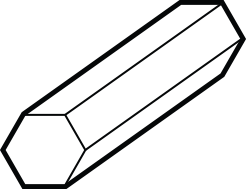
Hex is available in a wide range of alloys from high strength-to-weight ratio grades to grades that are easily machinable. Hex bars are often used for wheels, gears, shafts, bolts and other car parts, screws and tube fittings.
| Grade | Description |
|---|---|
| 1018 | Mild (low carbon) steel, strong and ductile, has good weldability properties. |
| 1045 | Medium carbon steel that can be forged satisfactorily. Most common shafting steel. |
| 1117 | This is a resulphurized steel with good machinability and surface finish, but not as good as the standard screw stocks. Its case hardening characteristics are superior and it develops an excellent core. It brazes satisfactorily but has no more than fair welding properties. A more ductile steel than others of lower manganese content and it cold forms well. Its machinability is rated at 89% of 1212. |
| 1215 | Free machining steel, commonly referred to as screw machine stock, especially suited for automatic screw machine operations where the major requirement is exceptional free-machining quality with a smooth, bright finish. Poor weldability. |
| Grade | Description |
|---|---|
| 4140 | Medium carbon steel that is widely used for general purposes. Good hardenability, strength, toughness, wear resistance, and ductility. |
| Grade | Description |
|---|---|
| 360 | Wide range of applications. Highest rated among copper alloys. Fair soldering and brazing capabilities. |
| Grade | Description |
|---|---|
| 2011 | One of the most commonly used high strength aluminum alloys. Low corrosion resistance. Commonly used when good strength-to-weight ratio is desired. |
| 2017 | Has high strength with excellent fatigue strength. Alloy 2017 also has very good machining characteristics. It is suitable for welding only by resistance welding. Alloy 2017 is used for various applications from high strength structural components, aircraft, machine construction, military equipment, and rivets. |
| 2024 | One of the most commonly used high strength aluminum alloys. Low corrosion resistance. Commonly used when good strength-to-weight ratio is desired. |
| 6061, 6262 | Heat treatable, structural alloy with medium strength and good weldability, formability, machinability, and relatively good corrosion resistance. |
| Grade | Description |
|---|---|
| 303 | Corrosion resistant to sterilizing solutions, most organic and inorganic chemicals, most dyes, nitric acid, and atmospheric exposures. |
| 304 | Offers resistance to corrosion, has good formability and can be readily welded by all methods. One of the most commonly used grades across the industry. |
| 304L | Extra low carbon avoids harmful carbide precipitation due to welding. Same corrosion resistance as 304 with lower mechanical properties. |
| 316L | Extra low carbon avoids harmful carbide precipitation due to welding. Same excellent corrosion resistance as 316. It exhibits the same high strength, toughness and workability as 304 alloys. |
| 416 | Good corrosion resistance. Additional sulfur in its chemistry makes 416 easier to machine. |